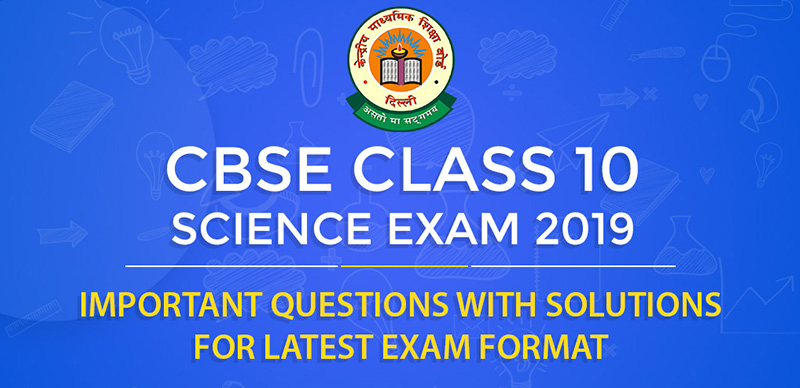
SHARING IS CARING
If our Website helped you a little, then kindly spread our voice using Social Networks. Spread our word to your readers, friends, teachers, students & all those close ones who deserve to know what you know now.
Class 10th Science : Important questions with solutions for latest exam format
For the CBSE Class 10 Science Exam 2019 which is to be conducted tomorrow, 13 March, we have collated important questions from all chapters of class 10 science. This set of important questions provided here forms a perfect source for the last minute revision before the exam.
Questions of different formats like short answer type, long answer type and based on practical skills have been provided separately.
Our subject experts have framed these questions after carrying the thorough analysis of the past years exam papers and the latest examination format and CBSE syllabus.
Here you will find the questions picked from every important topic of CBSE class 10 Science. Each question has been provided with an appropriate though simple solution which is easy to understand thereby helping you make an easy and effective preparation for CBSE class 10 Science Exam 2019.
Very Short Answer Type Questions
Q. Explain why a ray of light passing through the centre of curvature of concave minor gets reflected along the same path.
Ans.
The light falling on the centre of curvature is reflected back along the same path because the incident ray falls on the mirror along the normal to the reflecting surface.
Q. What is the important function of presence of ozone in earth’s atmosphere?
Ans.
Ozone is the Earth’s natural process for all life forms. It shields our planet from the UV radiations, as these ultraviolet rays are harmful for all the living things. Therefore, any change in the size of this layer will automatically affect the life of people, plants and animals living on earth.
Q. Dark reaction of photosynthesis does not need light. Do plants undergo dark reaction at night? Explain.
Ans.
Dark reaction does not mean that it occurs in the absence of light i.e., at night. Infact, it is the reaction occurring simultaneously with light reaction. It a chemical process occurring independent of light. This reaction is completely based on enzymes.
Short Answer Type Questions
Q. How are we able to see distant and nearby objects clearly? Which part of eye helps in changing curvature of lens? Why no image is formed at blind spot?
Ans.
We can see distant and near objects clearly because of the property of accommodation of eye. Accommodation is the name given to the ability of the lens of the eye to change its focal length and produce focused images of both distant and near objects on the retina.
Ciliary muscle helps in changing curvature of the lens. They are attached to the lens and contract or release to change the lens shape and curvature.
No image is formed at blind spot because there are no photoreceptors, i.e., cones and rods to detect the light and send it to brain.
Q. (a) Which property of carbon leads to formation of large number of compounds? Define it.
(b) What is the functional group in the following molecules?
(i) CH3CH2CH2OH
(ii) CH3COOH
Ans.
(a) The two features of carbon that give rise to a large number of compounds are as follows:
(i) Catenation: It is the ability to form bonds with other atoms of carbon.
(ii) Tetravalency: With the valency of four, carbon is capable of bonding with four other atoms.
(b)
| Compound | Functional group |
| (i) CH3CH2CH2OH | -OH (Hydroxyl group) |
| (ii) CH3COOH | -COOH (Carboxyl group) |
Q. (a) Why magnification is taken negative for real images and positive for virtual images?
(b) Why convex mirror is used in rear view mirrors and not concave mirror?
Ans.
(a) If image is real, it will be inverted which means height of image will be taken as negative. Also, the height of object is always positive.
Now as magnification = Height of image / Height of object.
Therefore, in case of real image,
Magnification = Height of image (-) / height of object (+)=Negative.
So, Magnification will be negative.
Similarly, if image is virtual, it will be erect.
Therefore, in case of virtual image,
Magnification = Height of image (+) / height of object (+)= Positive
So, Magnification will be positive.
(b) Convex mirror is commonly used in rear view mirrors in vehicles because it gives an erect, virtual, full size diminished image of distant objects with a wider field of view. Thus, convex mirrors enable the driver to view much larger area which is not possible with a concave mirror.
Long Answer Type Questions
Q. (a) What are ‘magnetic field lines’? How is the direction of a magnetic field at a point determined ?
(b) Draw two field lines around a bar magnet along its length on its two sides and mark the field directions on them by arrow marks.
Ans.
(a) The magnetic field lines are the pictorial representation of the strength and direction of the magnetic field.
The direction of the magnetic field at a point can be found by placing a small magnetic compass at that point. The north end of the needle of a compass indicates the direction of magnetic field at a point where it is placed.
(b) Magnetic field lines of a bar magnet emerge from the north pole and terminate at the south pole. Inside the magnet, the field lines emerge from the south pole and terminate at the north pole, as shown in the given figure.

Q. (a) Mention the pH range within which our body works. Explain how antacids
give relief from acidity. Write the name of one such antacid.
(b) Fresh milk has a pH of 6. How does the pH will change as it turns to curd? Explain your answer.
(c) A milkman adds a very small amount of baking soda to fresh milk. Why does this milk take a longer time to set as curd?
(d) Mention the nature of toothpastes. How do they prevent tooth decay?
Ans.
(a) Our stomach has pH equal to 2. Antacids neutralize the excess of acid in our body and gives relief from hyperacidity. Sodium hydrogencarbonate is one of such antacid.
(b) pH will decrease as it turns to curd because curd is acidic due to the presence of lactic acid.
(c) It takes longer time to set as curd as bacteria do not work well in presence of sodium hydrogencarbonate, i.e. fermentation will take place slowly.
(d) Toothpastes are basic in nature. They neutralize the acid formed in mouth which causes tooth decay.
Q. Atoms of eight elements A. B. C. D, E, F. G and H have the same number of electronic shells but different number of electrons in their outermost shell. It was found that elements A and G combine to form an ionic compound. This compound is added in a small amount to almost all vegetable dishes during cooking. Oxides of elements A and B are basic in nature while those of E and F are acidic. The oxide of D is almost neural. Based on the above information answer the following questions:
(i) To which group or period of the periodic table do the listed elements belong?
(ii) What would be the nature of compound formed by a combination of elements B and F?
(iii) Which two of these elements could definitely be metals?
(iv) Which one of the eight elements is most likely to be found in gaseous state at room temperature?
(v) If the number of electrons in the outermost shell of elements C and G are 3 and 7 respectively, write the formula of the compound formed by the combination of C and G.
Ans.
(i) The listed chemicals belong to third period; it includes Na, Mg, Al, Si, P, S, Cl& Ar.
(ii) Compound formed by the combination of B (Mg) and F (S) will result in formation of salt called MgSO4
(iii) Compound A (Na) and B (Mg) are definitely metals as their oxides are basic in nature.
(iv) Element H (Ar), is likely to be found in gaseous state at room temperature as it is the 8th element of the group so it would have 8 electrons in its outermost shell which is the electronic configuration of an Nobel gas.
(v) They will form AlCl3 (Aluminium chloride)
Practical Based Questions
Q. Mention the essential material (chemicals) to prepare soap in the laboratory. Describe in brief the test of determining the nature (acidic/alkaline) of the reaction mixture of saponification reaction.
Ans.
Raw Materials Required For preparation of soap in laboratory are :
- Vegetable oil
- Sodium Hydroxide
- Commom salt
Test to determine the nature of reaction mixture: When a red litmus paper is dipped in the reaction mixture, the paper changes its colour to blue. Hence, the reaction mixture of the saponification reaction is basic in nature.
Q. Write two precautions to be taken while identifying different parts of an embryo of a dicot seed.
Ans.
(i) The slide should be properly focused.
(ii) Slide should be observed first under low-power magnification and then under high-power magnification of the compound microscope.
Q. A student is to conduct an experiment to show CO2 is released during respiration. List two precautions that he/she must take for obtaining correct observation.
Ans.
Two precautions to be taken are:
(i) Germinating seeds (living) should be used.
(ii) The experiment set up must be air-tight.







 Profile
Profile Signout
Signout














 Quiz
Quiz
 Get latest Exam Updates
Get latest Exam Updates 










